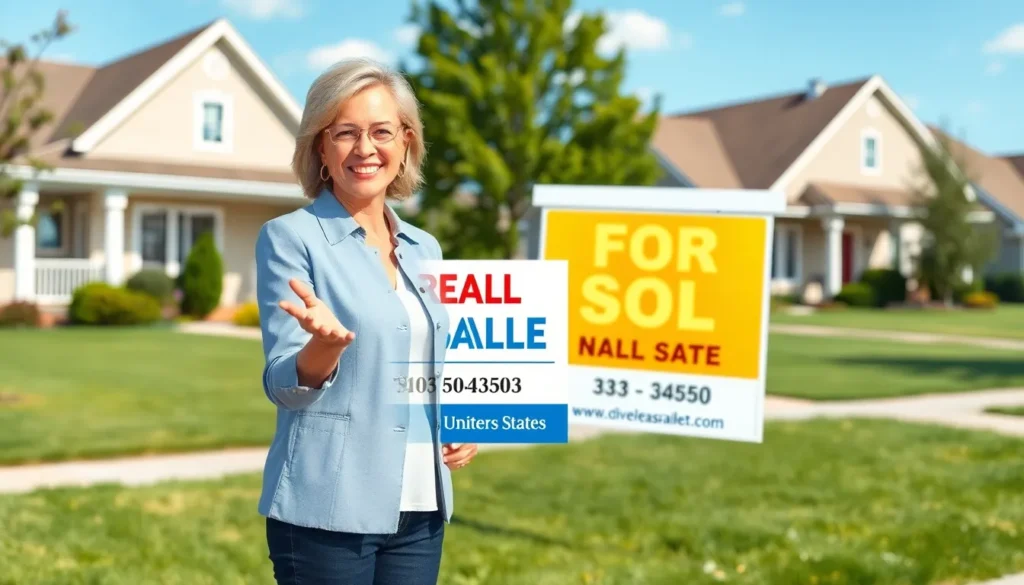In the fast-paced world of real estate, a well-placed sign can be a game-changer. Imagine driving down the street and spotting a vibrant sign that practically shouts, “Buy me!” or “Sell me!” It’s not just a piece of plastic; it’s a beacon for potential buyers and sellers alike. Real estate agents know that the right sign can turn a quiet neighborhood into a bustling marketplace faster than you can say “open house.”
But it’s not all about flashy designs and catchy slogans. A sign needs to convey professionalism and trustworthiness while still grabbing attention. Whether it’s a charming “For Sale” sign or an eye-catching open house banner, these signs play a crucial role in an agent’s marketing arsenal. So let’s dive into the world of real estate signage and discover how to make a statement that leaves a lasting impression.
Table of Contents
ToggleImportance Of Signs For Real Estate Agents
Real estate signs play a vital role in an agent’s marketing strategy. They enhance visibility and reinforce brand recognition, contributing significantly to an agent’s success.
Enhancing Visibility
Visibility serves as a primary benefit of real estate signs. Agents use signs to attract attention from prospective buyers and sellers. Strategically placed signs ensure properties appear prominently in local neighborhoods. High-quality, well-designed signs stand out, capturing interest even in competitive areas. Signs can communicate critical information like property status and contact details swiftly. Locations with dynamic signage create buzz, turning passive viewers into active interested parties. Effective visibility leads to increased showings and inquiries, making signs an essential tool in the real estate market.
Building Brand Recognition
Brand recognition emerges as another significant advantage of real estate signage. Consistent design across signs fosters a recognizable identity for agents. Incorporating logos, colors, and fonts allows for differentiation from competitors. The use of memorable taglines adds to identity retention, ensuring the audience recalls the brand. Regular exposure to well-branded signs builds trust and professionalism. Clients associate familiar names with credibility and expertise, eventually deciding to reach out. This trustworthiness establishes a lasting impression, benefiting future business opportunities and referrals.
Types Of Signs For Real Estate Agents

Real estate agents utilize various types of signs to enhance visibility and attract clients. Understanding these different options allows agents to choose the most effective signs for their marketing strategies.
Yard Signs
Yard signs serve a crucial role in real estate marketing. Not only do these signs display property information, but they also feature the agent’s branding prominently. High-quality materials and clear fonts ensure readability from a distance. Many agents use bold colors to attract attention, especially in residential areas. These signs often include QR codes, directing potential buyers to online listings for more details.
Open House Signs
Open house signs invite potential buyers to view a property during designated times. A well-placed sign grabs attention and generates interest in the property. Many agents utilize large and colorful designs, making them easily noticeable from the street. Information such as date, time, and the agent’s contact details should be clearly displayed. Effective open house signs create a welcoming atmosphere and encourage foot traffic.
Directional Signs
Directional signs guide potential buyers to properties and open houses. These signs strategically placed along roads help reduce confusion and enhance convenience. A combination of arrows and property details aids in navigation. Agents often use consistent branding on these signs for effective recognition. Properly placed directional signs can lead to increased showings and inquiries, ultimately boosting sales prospects.
Design Tips For Real Estate Signs
Effective design elevates real estate signs, enhancing visibility and promoting brand recognition. Attention to detail in color choice and font can significantly impact a sign’s effectiveness.
Choosing The Right Colors
Colors influence perception and emotion in real estate signage. Bright colors like yellow or orange attract attention, while blue and green evoke feelings of trust and stability. Agents should choose colors that align with their brand image, ensuring consistency across all marketing materials. For outdoor signs, visibility in various weather conditions remains crucial, so contrasting colors improve readability. It’s essential to consider local demographics and preferences, as these factors shape color interpretation in target markets. A thoughtful color palette can enhance memorability and create a lasting impression.
Font Selection
Font choice directly affects readability and professionalism in real estate signs. Bold, sans-serif fonts often stand out well from a distance, making them ideal for essential information. Using two or three complementary fonts maintains visual interest while avoiding clutter. Agents must prioritize legibility, ensuring that the font size remains large enough for passing drivers or pedestrians to read quickly. Avoid complex or ornate styles, as these can disrupt clarity. Consistent font usage across various signs and marketing channels reinforces brand identity and increases recognition. A well-chosen font embodies the agent’s professionalism and enhances the sign’s overall appeal.
Legal Considerations For Real Estate Signs
Real estate agents must navigate legal considerations when utilizing signage. Compliance with local regulations ensures successful marketing efforts.
Local Regulations
Agents should research specific local laws governing real estate signage. Different municipalities impose varied restrictions on sign size, materials, and messaging. For example, some areas limit signs to a maximum height of six feet or mandate specific colors that blend with neighborhood aesthetics. Violating these regulations can result in fines or the removal of signs. Checking zoning ordinances provides clarity on permissible signage types in designated areas. Ignoring local guidelines risks damaging reputations as well as business integrity.
Sign Placement Restrictions
Placement of real estate signs also faces regulations that agents must respect. Many communities require signs to be situated a certain distance from streets or property lines. Commonly, a distance of three to five feet is mandated to maintain public safety and visibility. Additionally, some areas prohibit placing signs in residential zones without permission from homeowners associations. Following these restrictions helps agents avoid conflicts with neighbors and ensures signage remains effective. Understanding placement guidelines allows for effective marketing strategies while maintaining good relationships within communities.
Real estate signs are more than just marketing tools; they’re essential for establishing an agent’s presence in the market. By leveraging effective signage, agents can significantly enhance their visibility and brand recognition.
The right design choices not only attract attention but also communicate professionalism and trust. Understanding local regulations and placing signs strategically can further amplify their impact.
Ultimately, investing in high-quality, well-designed signs can lead to increased inquiries and showings, paving the way for future success in the competitive real estate landscape.




